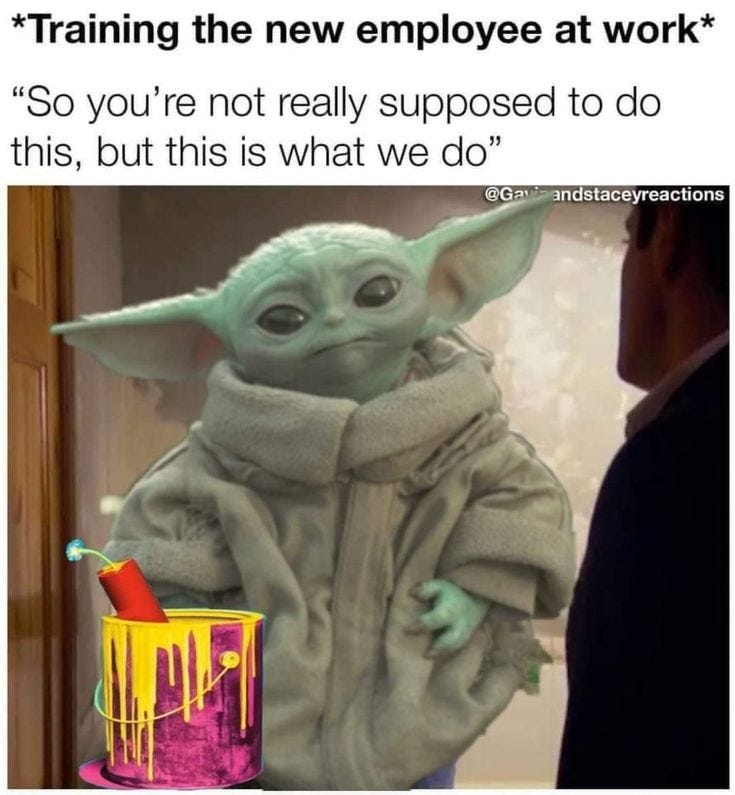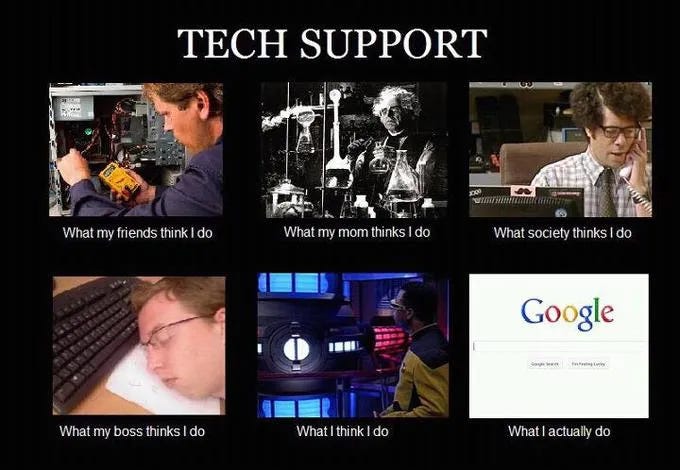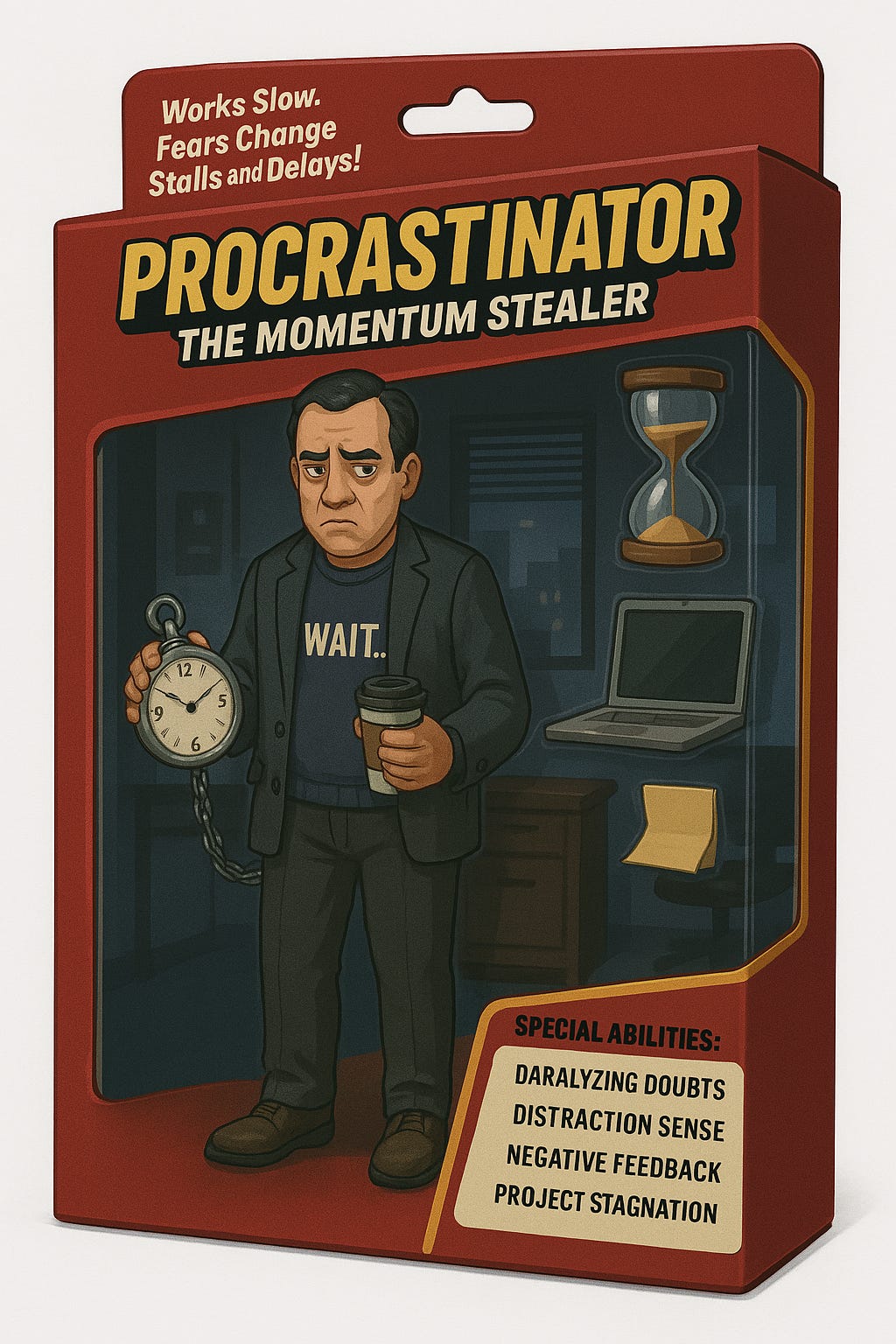This screenshot gets more buy-in than a $10,000 offsite
I showed one image. The room lit up. Here’s why it worked.
People often ask me, “Where do you come up with your workshop ideas?”
They’re expecting me to say a leadership book, attending someone else’s workshop, or something fancy from Harvard Business Review.
But the truth?
I get my best ideas while scrolling social media.
Not the #inspo quotes or LinkedIn hustle posts. I mean the memes.
If I see something that makes me laugh and already has thousands of reactions? That’s a signal. That’s data. There’s no point creating stuff from scratch when you have a proof of concept.
So, save it. Use it. Turn it into engagement gold.
The screenshot that said more than a strategy deck ever could
A while ago, I was prepping a session on contractor onboarding for a room full of asset managers.
As I was scrolling Facebook, I stumbled across a Baby Yoda meme (Grogu, if we’re being correct).
It was a side-by-side image that poked fun at the difference between “official onboarding” and “actual onboarding.”
It cracked me up.
And the comments? Full of people tagging colleagues, saying, “This is us 😂”
So I saved it.
And in that session, instead of kicking off with a process map or compliance slide, I opened with that meme.
Phones came out.
Laughter erupted.
But most importantly, people instantly got it.
That single screenshot did what a $10,000 offsite tries to do, but in seconds.
It created connection. It made people recognise they were in the right room.
It’s funny because it’s true (and yet, it feels wrong to admit it).
When I see something trending, like this meme, or a viral "expectation vs reality" post, I don’t just enjoy it and move on. I zoom in.
I ask myself, “Why did this work so well?”
Then I save it.
I’ve got an album on my phone called Inspo, filled with screenshots, reels, memes, and random gems I know I’ll use in a speech or workshop someday.
With all of that interest on a post, you have instant confirmation.
This stuff works. Not just online, but in rooms filled with professionals (AKA, humans).
That’s your litmus test for engagement.
If it triggers a response for you, it can do the same for others.
Inside most organisations, people have no idea what other teams actually do.
That’s not an opinion. It’s not fake news.
You’ve probably felt it (I have!) when teams work in the same company but operate like strangers.
Assumptions fly. Misunderstandings build. And talented people stay under the radar because no one really sees their impact.
So when I partnered with a leadership team who genuinely cared about this, the ask was clear: “Help us break down the silos”
But we weren’t going to do it with org charts or project dashboards. We needed something faster. And yes, a bit more fun.
The creative solution
We borrowed a popular meme format, one you’ve probably seen before, and turned it into a rapid-fire storytelling activity for the entire organisation:
And it worked.
Here’s the format:
The ask:
Each department created a short, visual presentation, embedding some of these prompts as slide titles:
What society thinks we do
What other teams within the company think we do
What our boss thinks we do
What we actually do
To keep it moving, we popped a 20-second timer per slide (this was part of a broader presentation from each team, sharing other things like wins, opportunities, challenges, what help they needed).
What happened next surprised everyone
The usually quiet commercial team turned out to be hilarious. The IT group used cat memes. Marketing poked fun at their “glamorous” reputation.
The result? People didn’t just learn about other teams, they understood them.
They empathised. They laughed. They connected.
This wasn’t just entertainment. It was reputation-building.
It was Work Fame in action.
Why this hits differently
At its core, Work Fame is about being known, seen, and understood for the real value you bring to your work. It’s not about showing off. It’s about being recognised.
This super quick activity taps right into that.
Here’s why it works:
It’s visually sticky. Memes are made to be remembered
It invites vulnerability in a way that feels safe
It overcomes assumptions by naming perceptions out loud
It builds clarity and connection across teams, fast
More importantly? It’s light. It’s fun.
Your turn
If you’re a team leader, try this in your next team meeting, or use it as an onboarding ritual.
If you’re a founder or solopreneur, create your own version and use it as your next intro slide.
Whatever your role, remember:
Being known beats being busy
Recognition beats explanation
And yes, memes can build your Work Fame
Want ideas on the daily?
🎙 Join me daily on Leanne on Demand, where I recently celebrated 100 episodes! On Episode 🌴100, a fake human interviews me. Or, you can listen to the most popular recent episode: 🌴98. How I snap out of a rut (no sound baths or silent getaways required).
Also, while everyone is busy posting their AI-generated action figure…
I decided to ask Chat GPT to create the villain in my life.
Here he is.
Thanks for reading!
I’d love to hear from you:
Respond in the comments:
→ What would you include in your ‘What I Actually Do’ slide?
🌴
Leanne “fishing for memes” Hughes
P.S. If you’re reading this on Thursday 10 April 5pm ET (USA) / Friday 11 April at 7am AEST, the Rockstar of Consulting, Alan Weiss and I are live-streaming right now on how high performers price for impact. Join us for free on LinkedIn Live or YouTube.
P.P.S. On 21 May, I’m hosting a one-time-only masterclass and it’s for a good cause.
I’m sleeping rough to raise money for Australians without a home. 100% of your donation goes to ending homelessness. 📩 Donate here → get the invite → do some good.
P.P.P.S. If this made you smile, sparked an idea, or got you thinking—tap the ❤️. It helps me know what’s hitting home.







I love this! huge fan of memes - also known to drop a few gifs in as well esp for virtual workshops.
And here is every B2B sayjng "that doesn't work for non-consumer brands" because they're allergic to relatability 😉 🤢